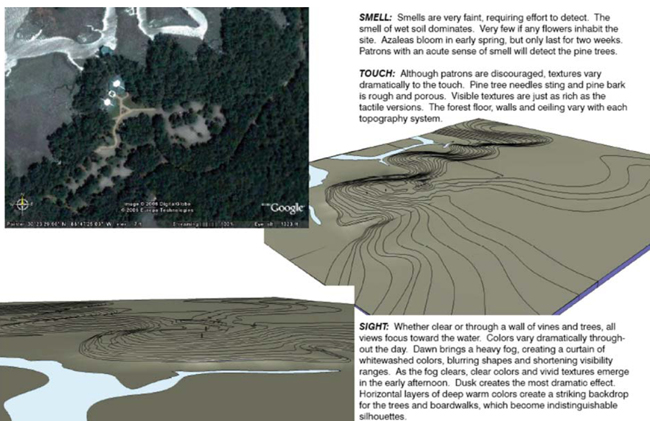Comprehensive Architectural Design Studio
Senior Studio
Site Analysis - Senses

Design Performance Objective |
Comprehensive Building Design Project:
William M Colmer Visitors Center and Park Headquarters
Site Analysis - Senses
|
Student: Amy Fruge |
| |
|
Fall 2007 Arch. 5001 (UG) Comprehensive Architectural Design Studio
Part 1 - Site Analysis - Senses
In the first phase of the project the students were instructed to produce a written program document with a problem statement and statement of intent, a written and graphic site analysis/interpretation, and an analysis ofappropriate precedents. These two images illustrate a few of these. The objective of these exercises was to develop an understanding of the relationship between the building program and the site that would serve to facilitate the realization of the designer’s intentions as the design process unfolded.
|
Investigative Strategy |
Field measurements and observations, client and user interviews, “Google Earth”, sensory perceptions, etc.
|
Evaluation Process |
|
Individual documents were evaluated based on the following: document form
(appearance, layout, spelling, grammar, readability); graphic representations;
understanding and analysis of basic site, precedent, and program information; interpretation of this information; statement of design intentions; and active participation on research teams and in on-site exercises. |
Evaluative Criteria |
Document form (appearance, layout, spelling, grammar, readability), graphic
representations, quality of observations.
|
Cautions - Possible Confusions |
None
|
Range of Applicability in terms of CLIMATE |
This type of project responded to the HOT HUMID climate zone in this instance, but it can easily be modified to suit any climate type. |
Range of Applicability in terms of TYPE |
This type of approach is suitable for any scale or type of building. |
Reference Material |
Hinchman, Hannah. A Trail Through Leaves: The Journal as a Path to Place. (esp. “The World as Events”)
Lynch, Kevin. Site Planning. (esp. Chapter 6 “The Sensed Landscape and It’s Materials”)
Norberg-Schulz, Christian. “The Phenomenon of Place.” From Theorizing a New Agenda for Architecture, Kate Nesbitt, ed.
Potteiger, M. and Purinton, J. Landscape Narratives. (esp. “The Nature of Landscape Narratives”)
Sewall, Laura. Sight and Sensibility. (esp. Chapter 1 “Vaeieties of Visual Experience”) |
Duration of Exercise |
Approximately three weeks for the Site Analysis Phase.
Two days on site required as a group.
Additional site visits as required by individual studenys and small groups. |
Degree of Difficulty / Previous Knowledge Required |
Easy for some, challenging for others.
Depends on their perceptual skills.
|
|
|
|

